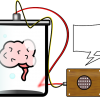10 Magnet Facts To Help Your Brain Get Fit in 2015
While you’re working out at the gym in the coming year, don’t forget to work out one of the most important muscles in your body━your brain. (For the record, your brain isn’t technically a muscle by itself.) However, like a muscle, your brain gets stronger as you use it more often. In honor of getting your brain fit for the new year, we have compiled a list of magnet facts to get you started.
- The largest magnet on Earth is, in fact, the Earth. Our planet acts as a bar magnet and has a magnetic north and south pole. Notice that we said the Earth was the largest magnet but not the strongest.
- The strongest magnet on Earth is not the Earth. Size alone doesn’t determine magnet strength. Many other factors like materials, grade, etc. factor into the strength of a magnet. The strongest, nondestructive magnet is a man-made one housed by the National High Magnetic Field Laboratory in Los Alamos.
- Magnets still work in space. Magnets emit their own external magnetic fields, so they still work in space. For proof, check out this video in which astronaut, Richard Garriott, puts it to the test.
- The moon once had a magnetic field and it may have been stronger than the Earth’s. The moon has no global magnetic field today. However, by studying lunar rocks, researchers recently discovered that the moon once had a molten core and magnetic field like the Earth.
- Only 2 planets in our galaxy do not have a global magnetic field and those planets are: Venus and Mars. These planets may have had a magnetic field at one point, however. The rest of the planets have magnetic fields and many of those are stronger than Earth’s.
- You can use magnets to levitate. Magnetic levitation can occur when two opposing magnetic poles face another and repel. It can also occur when a superconductor is cooled to an extremely low temperature, causing it to enter a state of zero electrical resistance. The latter is the concept by which the fast-moving Maglev trains are built.
- If you heat a magnet, it can lose its magnetic strength. When heated to a certain temperature, permanent magnets will lose strength. When the magnet cools back to room temperature, it can regain that strength. However, if it reaches its Curie temperature, it will likely be demagnetized forever.
- If you cool a magnet, it can get stronger. When exposed to cold temperatures, permanent magnet strength can increase. However, the increase is only slight and like heat, if the temperature goes to extremes another reaction will happen. In this case, spin reorientation may occur.
- High powered magnets will still work in water. This may seem like an easy one, but magnetism will still occur underwater. Some fisherman even use magnets to retrieve lost items. The only worry is that the water will corrode the magnet. This is especially the case for neodymium magnets.
- Some sharks detect magnets. Sharks and some other marine life have sensory organs called ampullae of Lumpini. These organs are responsible for detecting magnetic fields and for some shark species, an external magnetic field can act as a repellant.

